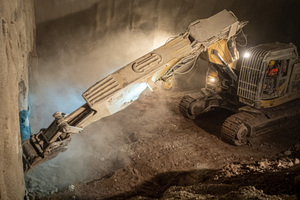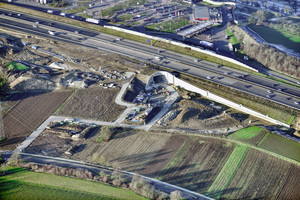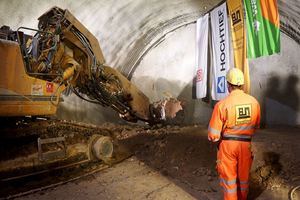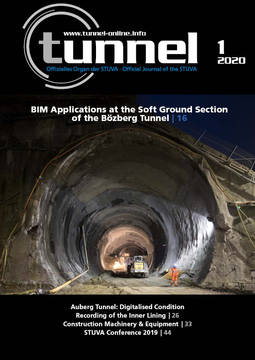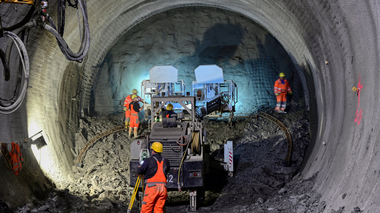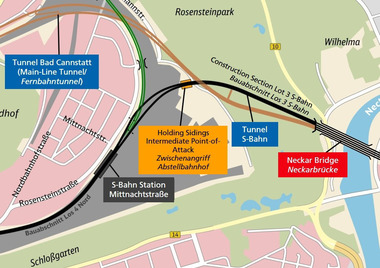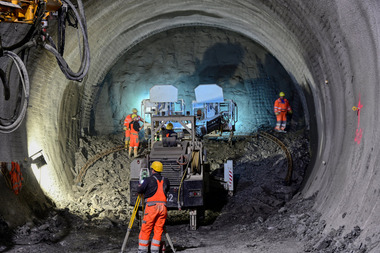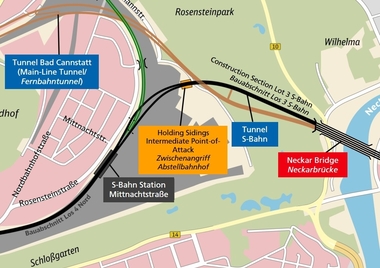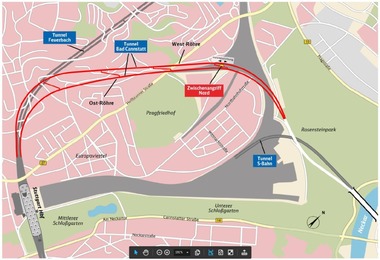Stuttgart–Ulm Rail Project: Progress on the Tunnel Projects
DB Breaks through to the Main Station from the South with the First Tunnel
The next breakthrough on the Stuttgart 21 Project: on 11 February 2020, the tunnel drive from the south arrived at the future main station in Stuttgart. The miners in the first bore of the Filder Tunnel arrived at the south head of the through station on 11 February 2020 after 15 months of work.
Together with the tunnel portal at the Kriegsberg in the north of the new platform hall, the future main station can now be accessed through three of the four tunnels. This breakthrough creates for the first time a continuous connection both to the Filder Plain south of the state capital and to the existing line in the Neckar Valley to the north.
“The driving of the large cross-section ran considerably faster than forecast. This is an excellent performance by the miners, engineers and involved consultants. We are proud of their achievement”, said Günter Osthoff, the responsible project manager for the planning sections 1.2 and 1.6a for DB Projekt Stuttgart–Ulm GmbH.
Breakthrough of the Second Bore Should Be Early this Year
Due to the rock properties, excavators are excavating most of the tunnels in the south approach area to the future station. The section consists of two two-track tunnels about 230 m long, excavated in full section with an arched profile with a height of 18 m and a width of nearly 20 m. The cover between tunnel crown and the buildings in the Kerner city quarter reduces from 47 m to about 8 m.
The south approach area is the last section of the 9.5 km long Filder Tunnel, which has been bored by a tunnel boring machine. In the Stuttgart Valley, it is not only connected to the future main station but also to the conventionally excavated Obertürkheim Tunnel in the direction of the Neckar Valley. The second bore, in which 67 m still remains, should be broken through in early 2020.
Second Tunnel Breakthrough in Untertürkheim
About a month after the successful breakthrough of the first bore of the Untertürkheim Tunnel, the miners broke through the second bore into the open air in the Neckar Valley on 16 December 2019. The Obertürkheim Tunnel and the 1080 m long branch to Untertürkheim will connect the future main station to the Neckar valley as part of the reorganisation of the Stuttgart rail node. The breakthrough in Untertürkheim was achieved earlier than expected in spite of numerous technical and geological challenges. In two years of tunnelling toward Untertürkheim, the tunnellers of joint venture ATCOST 21 successfully passed under the Neckar and the Kraftwerk canal twice each, as well as under five existing railway lines under continued operation.
Denkendorf Tunnel: Autobahn Diverted Back
In the middle of December 2019, construction of the Denkendorf Tunnel was largely completed. The new line from Stuttgart to Ulm will pass through the tunnel near Denkendorf under the Autobahn A8. In the night from 16 to 17 December 2019, the Autobahn above the tunnel was diverted back to its original alignment.
Construction of the 768 m long tunnel near the Denkendorf service area started in August 2015. The tunnel was constructed by cut-and-cover, for which the lanes of the Autobahn A8 had to be diverted several times. The number of lanes on the autobahn was maintained through the entire construction period.
S-Bahn Tunnel under the Rosenstein Park
At the end of November 2019, the Deutsche Bahn had already completed the two-track part of the Rosenstein S-Bahn Tunnel, another part of the Stuttgart 21 project, after only five months. The Rosenstein S-Bahn Tunnel will be 1170 m long when complete. The 520 m long two-track part of the tunnel was driven from the Rosenstein portal, with another part being excavated from the intermediate starting point at the stabling station. Directly next to the S-Bahn Tunnel on the Rosenstein slope, the two-track part of the main line tunnel started construction in Dezember 2018, and was completed in October 2019.
For the construction of the tunnel from the bank of the Neckar, six trees had to be felled in February 2018, in which the strictly protected hermit beetle was suspected. For this reason, the Deutsche Bahn had to apply for a planning variation from the Federal Railway Office in August 2015. In the course of this procedure, the approval of the EU Commission was also necessary, which was issued in January 2018 – two and a half years after the variation application. This procedure delayed construction of the Rosenstein S-Bahn Tunnel.

